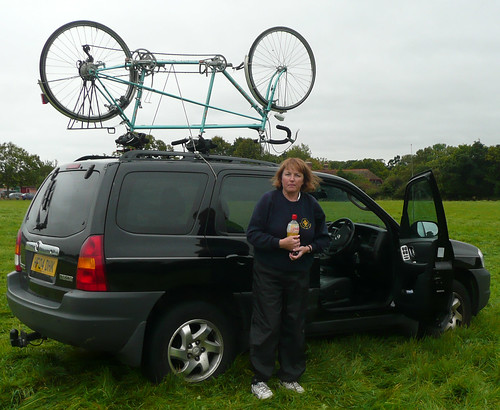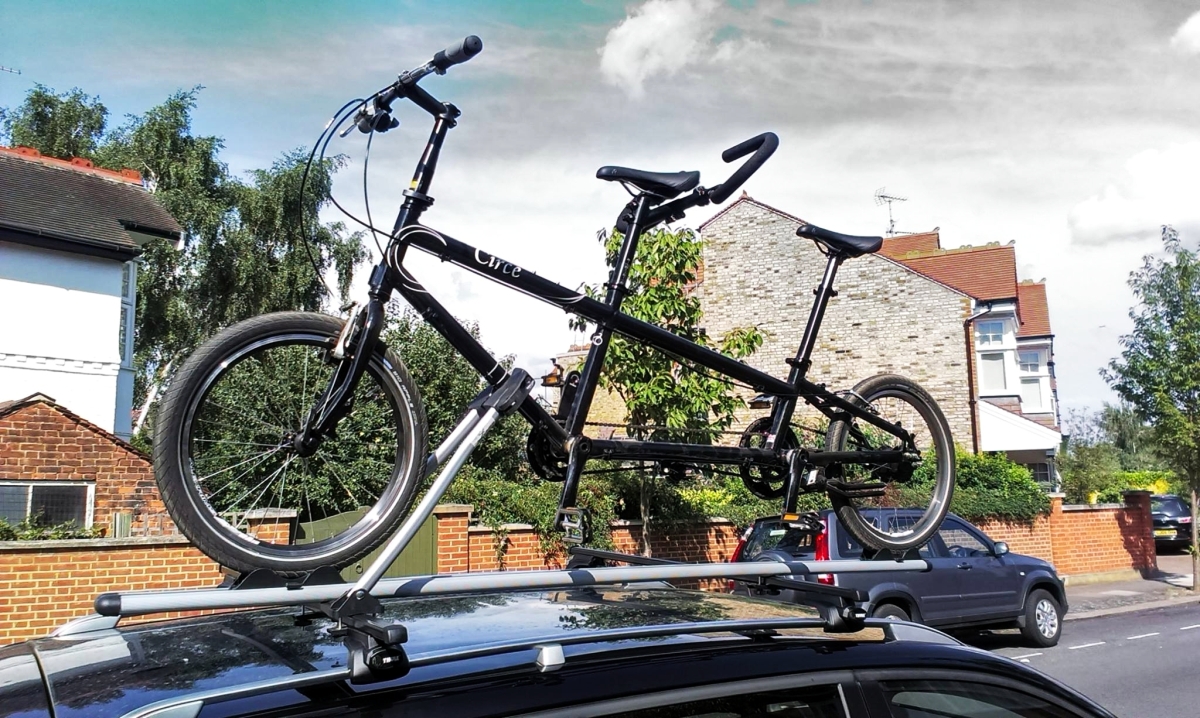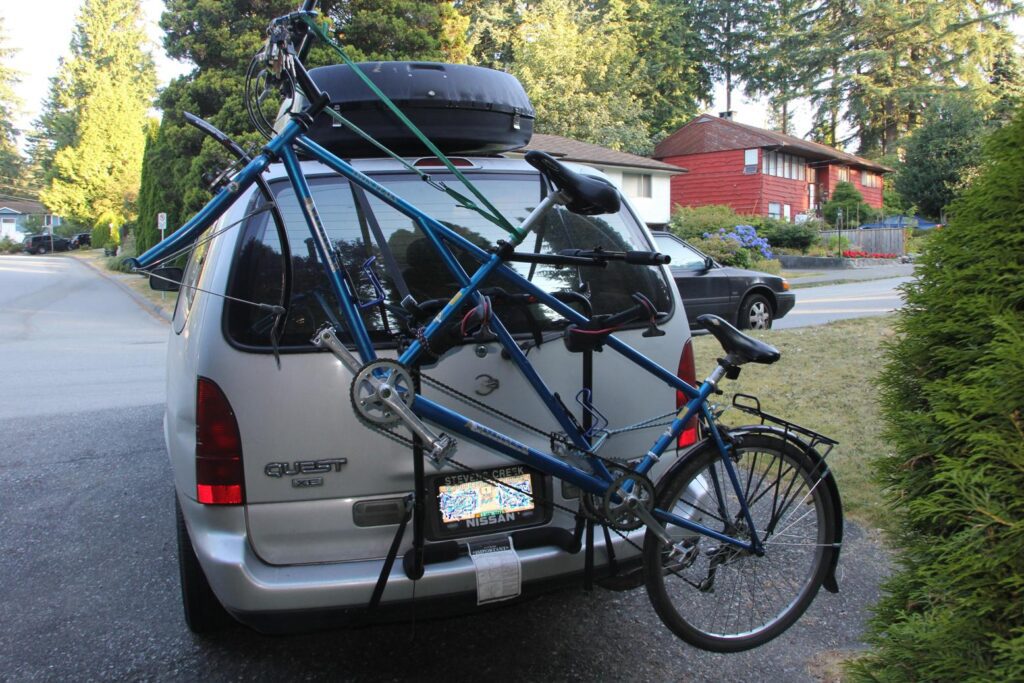Periodic Safety Inspections
Carrying a tandem bike on a car requires periodic safety inspections to ensure secure transportation. These inspections help prevent accidents and damage to the bike during transportation.
Check Bike Rack And Straps For Tightness
When it comes to carrying a tandem bike in a car, periodic safety inspections are crucial. One of the first things you should do is check the bike rack and straps for tightness. It’s essential to ensure that the rack is securely attached to your car and that the straps are properly fastened to hold the tandem bike in place. Start by examining the bike rack, making sure it is firmly attached to the car’s roof or hitch. Give it a gentle shake to see if it wobbles or feels loose. If it does, tighten the bolts or straps as necessary to enhance stability during travel.
Next, assess the straps used to secure the tandem bike to the rack. Check for any signs of wear or fraying that may compromise their strength. Replace worn-out straps to maintain the overall safety of the transportation setup. Remember to test the tightness of the straps by pulling them firmly. They should feel secure and show no signs of slippage or looseness. Pay attention to the connection points between the rack and the bike to ensure a tight fit, reducing the risk of the tandem bike shifting or falling during transit.
Inspect The Tandem Bike For Any Issues
Another crucial step in periodic safety inspections is thoroughly examining the tandem bike itself for any issues. By doing so, you can identify and address any potential problems that may affect safety while traveling. Begin by inspecting the frame of the tandem bike. Look for any cracks or structural weaknesses that may compromise its integrity. Check the joints and welds, ensuring they are secure and undamaged. Remember, a strong frame is essential for a safe and smooth journey. Continue the inspection by examining the wheels and tires. Make sure the tires are inflated to the proper pressure as indicated by the manufacturer. Inspect the rims for any dents or warping that could cause instability during transport.
Also, check the spokes for tightness and ensure they are not damaged or broken. Inspect the brake system to guarantee its effectiveness. Ensure the brake pads are in good condition and have sufficient depth. Test the brakes by engaging them and observing if they respond promptly and effectively. If anything seems off, it’s crucial to address the issue before hitting the road. Lastly, examine the pedals, handlebars, and seats. Ensure that they are tightened securely, with no loose or faulty components. Test the steering and make sure it operates smoothly and without any resistance. By performing these periodic safety inspections, you can travel confidently, knowing that your tandem bike and transportation setup are in optimal condition. Remember, regular checks ensure the safety of both the bike and other road users.

Credit: forum.cyclinguk.org
Storing The Tandem Bike
When it comes to storing your tandem bike after a thrilling ride, it’s crucial to ensure its safety and protection. Proper storage helps maintain the bike’s condition, ensuring it’s ready for the next adventure. Here’s how to store your tandem bike securely and conveniently.
Follow the Manufacturer’s Instructions For Rack Removal
Following the manufacturer’s instructions for rack removal is essential to prevent any damage to either the bike or the car. It’s important to carefully detach the tandem bike from the car rack, as per the specific guidelines provided by the bike rack’s manufacturer. This ensures a safe and smooth removal process, preventing any mishaps or potential damage.
Store The Bike In A Secure And Dry Location
Storing the bike in a secure and dry location is paramount for its preservation. After removing the tandem bike from the car, make sure to store it in a place that is secure and shielded from potential hazards. A dry location helps prevent rust and corrosion, ensuring the bike’s components remain in optimal condition for longer durations.
Frequently Asked Questions For How To Carry A Tandem Bike On A Car
How Do You Travel With A Tandem?
When traveling with a tandem, secure it on a specialized bike rack, ensuring it is properly attached. Make sure to check the dimensions and weight limitations of the rack beforehand. Additionally, remove any detachable parts to avoid damage during transport.
Obtain a travel bag or box to protect the tandem during flights or long journeys.
How Do You Pack A Tandem Bike?
To pack a tandem bike, remove pedals, wheels, and handlebars. Use foam or padding to protect parts. Place in a bike box with care, securing all loose items. Consider professional help for disassembly and packing for safety.
What Is The Best Way To Carry A Bike On A Car?
The best way to carry a bike in a car is by using a bike rack that attaches to the back or roof of the car. Make sure it is securely installed and the bike is properly fastened to the rack to prevent any damage or accidents.
How Do You Carry A Bike Without A Hitch?
You can carry a bike without a hitch by using a trunk-mounted bike rack. Simply attach the rack to your vehicle’s trunk and secure the bike in place. Ensure the rack is properly installed and the bike is secured according to the manufacturer’s instructions for safe transportation.
Conclusion
Learning how to carry a tandem bike in a car is crucial for outdoor enthusiasts. By following the steps outlined in this blog post, you can safely transport your tandem bike for your next adventure. Keep in mind the safety precautions and enjoy your biking journey hassle-free.
To carry a tandem bike on a car, use a tandem bike rack that attaches to the rear of your vehicle. The rack should securely hold both bikes in place to prevent any damage while driving.
When it comes to transporting a tandem bike, many people find it challenging due to its size and weight. However, with the right equipment and proper knowledge, it can be done easily and safely. Tandem bikes are popular for recreational riding and biking competitions, making it important for enthusiasts to know how to transport them conveniently.
We will provide a guide on how to carry a tandem bike on a car, discussing the different options and methods available for safely transporting a tandem bike to your desired destination. Whether you’re planning a bike trip or need to transport a tandem bike for an event, this information will ensure your tandem bike arrives safely and securely.
Choosing The Right Bike Rack
When it comes to transporting a tandem bike on your car, choosing the right bike rack is essential. Not all bike racks are suitable for carrying tandems, which are longer and heavier than regular bikes. In this section, we will discuss how to choose the right bike rack for your tandem, considering factors such as your car’s hitch type, the weight capacity needed, and compatibility with tandem bikes.
Consider Your Car’s Hitch Type
Before selecting a bike rack, determine the type of hitch your car has. There are various hitch types, including Class I, II, III, and IV, each with specific weight and size capacities. It is crucial to know your car’s hitch type to ensure compatibility with the bike rack.
Determine The Weight Capacity Needed
One of the most important factors to consider when choosing a bike rack for your tandem is the weight capacity. Tandems are heavier compared to regular bikes, so make sure that the bike rack you choose can support the weight of your tandem. Check the rack’s weight capacity specifications to ensure it can handle the weight of both riders and the bike itself.
Ensure Compatibility With Tandem Bikes
Not all bike racks are designed to accommodate tandem bikes due to their longer size and different frame shapes. Look for a bike rack specifically designed for tandem bikes or one with adjustable arms that can properly secure the longer frame. Additionally, consider the stability and security features of the rack to ensure your tandem bike is adequately protected during transit.
In conclusion, when carrying a tandem bike in your car, choosing the right bike rack is crucial. Consider your car’s hitch type, determine the weight capacity needed, and ensure compatibility with tandem bikes. By selecting the appropriate bike rack, you can transport your tandem safely and securely to your desired destination.

Credit: bicycles.stackexchange.com
Preparing The Tandem Bike
To carry a tandem bike in a car, start by removing the front wheel and securing it to a bike rack. Use adjustable straps to fasten the tandem bike securely to the rack. Check the connections before driving off to ensure safe transportation.
Remove Any Detachable Parts
Detach pedals, front wheel, saddles, if possible, to reduce the bike’s width.
Secure Loose Or Moving Components
Tighten screws, and bolts, to prevent parts from shifting during transport.
Clean And Lubricate The Chains
Remove dirt from chains, and apply lubricant for a smooth and effective ride.
Loading The Tandem Bike
When it comes to loading a tandem bike onto a car, proper positioning and securing the bike is essential for a safe and stress-free journey.
Position The Bike In The Rack Correctly
Positioning the tandem bike on the rack is crucial to ensure both safety and stability during transit. Start by ensuring that the bike is centered on the rack with the heavier end facing towards the vehicle. This helps maintain a balanced weight distribution and reduces the risk of swaying or wobbling during transport.
Attach The Bike To The Rack With Straps Or Clamps
Once the bike is properly positioned, it’s time to secure it to the rack using straps or clamps. Carefully wrap the straps or place the clamps around the frame of the bike and tighten them securely. Be sure to double-check the attachment to prevent any potential shifting or movement while driving.
Ensure A Secure Attachment
Double-check the attachment to make sure it’s firmly in place and there is no loose end. A secure attachment is crucial to avoid any accidents while on the road. Once everything is in place, give the bike a gentle shake to ensure it’s firmly secured before hitting the road.
Securing The Tandem Bike
When it comes to carrying a tandem bike on a car, securing the bike properly is crucial for both safety and peace of mind. With the right techniques, you can ensure that your tandem bike stays firmly in place during transportation, preventing any potential accidents on the road.
Use Additional Bungee Cords Or Tie-down Straps
When securing a tandem bike on a car, it’s important to go above and beyond when it comes to stability. In addition to the standard rack or roof-mounted system, using additional bungee cords or tie-down straps can provide extra security. These can be attached to various points on the bike and the car to minimize any movement during transit.
Test The Stability And Security Of The Bike
After securing the tandem bike using the recommended methods, it’s critical to test the stability and security of the bike before hitting the road. This involves gently rocking the bike and checking each attachment point to ensure it’s securely fastened. If there’s any sign of movement or slack, adjustments should be made immediately to avoid any potential hazards during travel.
Adjusting The Car’s Rear View
Verify Clear Vision Through Side Mirrors
Before carrying a tandem bike, ensure side mirrors provide clear vision.
- Check for any obstructions that may hinder viewing angles.
- Adjust side mirrors to have a wide field of vision.
- Ensure no blind spots exist that could impede safe driving.
By prioritizing clear visibility, you enhance safety while transporting the tandem bike.
Adjust Rearview Mirror If Necessary
If the rearview mirror obstructs your view, adjust it accordingly.
- Position the rearview mirror to have a clear line of sight behind the car.
- Ensure it provides a complete view of the road and any potential obstacles.
- Regularly reassess the rearview mirror during your journey to maintain visibility.
Proper adjustment of the rearview mirror is crucial for safe driving with a tandem bike on your car.

Credit: www.circecycles.com
Driving With A Tandem Bike
Carrying a tandem bike in your car opens up a world of adventure for you and your cycling partner. However, before hitting the road, it’s important to know how to drive safely with a tandem bike secured on top. In this section, we will discuss some important points to keep in mind when driving with a tandem bike, including taking caution on turns and curves, maintaining the recommended speed limit, and being mindful of the extra length.
Take Caution On Turns And Curves
When driving with a tandem bike on top of your car, it’s crucial to exercise caution, especially when navigating turns and curves. The extra length of the tandem bike can affect your car’s balance and handling. To ensure a smooth and safe journey, follow these tips:
- Approach turns and curves with reduced speed to maintain stability.
- Steer gently and smoothly, avoiding sudden or sharp movements that can cause the tandem bike to sway.
- Take wider turns to accommodate the extended length of the bike.
- Keep an eye on the bike through your side view mirrors to monitor its position.
- Stay aware of your surroundings and the presence of other vehicles, cyclists, or pedestrians.
Maintain the Recommended Speed Limit
Adhering to the recommended speed limit is essential when driving with a tandem bike. Excessive speed can increase the risk of accidents and compromise the stability of the bike. Follow these guidelines to ensure a safe and enjoyable journey:
- Abide by the speed limits set by road authorities and adjust your driving accordingly.
- Stay within the speed range suggested by your car’s manufacturer when carrying a tandem bike.
- Consider the added weight and wind resistance caused by the tandem bike, which may require you to drive slightly slower than usual.
- Allow ample distance between your car and other vehicles to react promptly in unexpected situations.
- Remember, safety should always take precedence over speed.
Be Mindful Of Extra Length
Driving with a tandem bike requires a heightened awareness of the extra length it adds to your car. Failing to account for this increased length can lead to collisions or mishaps on the road. Keep the following pointers in mind:
- Select routes that accommodate longer vehicles and provide enough clearance for your car with the tandem bike on top.
- Take note of low-hanging branches, bridges, or tunnels that may pose a risk of collision.
- Signal lane changes and turns in advance to ensure other drivers are aware of your intentions.
- Take care when parking, ensuring the tandem bike doesn’t hang over into adjacent parking spaces or obstruct traffic.
- Secure the tandem bike properly to minimize any movement that can compromise the car’s handling.
By following these driving tips, you can confidently and safely transport your tandem bike to your desired cycling destinations. Now that you know how to drive with a tandem bike, it’s time to hit the road, enjoy the ride, and create incredible memories with your cycling partner!
Periodic Safety Inspections
Carrying a tandem bike on a car requires periodic safety inspections to ensure secure transportation. These inspections help prevent accidents and damage to the bike during transportation.
Check Bike Rack And Straps For Tightness
When it comes to carrying a tandem bike in a car, periodic safety inspections are crucial. One of the first things you should do is check the bike rack and straps for tightness. It’s essential to ensure that the rack is securely attached to your car and that the straps are properly fastened to hold the tandem bike in place. Start by examining the bike rack, making sure it is firmly attached to the car’s roof or hitch. Give it a gentle shake to see if it wobbles or feels loose. If it does, tighten the bolts or straps as necessary to enhance stability during travel.
Next, assess the straps used to secure the tandem bike to the rack. Check for any signs of wear or fraying that may compromise their strength. Replace worn-out straps to maintain the overall safety of the transportation setup. Remember to test the tightness of the straps by pulling them firmly. They should feel secure and show no signs of slippage or looseness. Pay attention to the connection points between the rack and the bike to ensure a tight fit, reducing the risk of the tandem bike shifting or falling during transit.
Inspect The Tandem Bike For Any Issues
Another crucial step in periodic safety inspections is thoroughly examining the tandem bike itself for any issues. By doing so, you can identify and address any potential problems that may affect safety while traveling. Begin by inspecting the frame of the tandem bike. Look for any cracks or structural weaknesses that may compromise its integrity. Check the joints and welds, ensuring they are secure and undamaged. Remember, a strong frame is essential for a safe and smooth journey. Continue the inspection by examining the wheels and tires. Make sure the tires are inflated to the proper pressure as indicated by the manufacturer. Inspect the rims for any dents or warping that could cause instability during transport.
Also, check the spokes for tightness and ensure they are not damaged or broken. Inspect the brake system to guarantee its effectiveness. Ensure the brake pads are in good condition and have sufficient depth. Test the brakes by engaging them and observing if they respond promptly and effectively. If anything seems off, it’s crucial to address the issue before hitting the road. Lastly, examine the pedals, handlebars, and seats. Ensure that they are tightened securely, with no loose or faulty components. Test the steering and make sure it operates smoothly and without any resistance. By performing these periodic safety inspections, you can travel confidently, knowing that your tandem bike and transportation setup are in optimal condition. Remember, regular checks ensure the safety of both the bike and other road users.

Credit: forum.cyclinguk.org
Storing The Tandem Bike
When it comes to storing your tandem bike after a thrilling ride, it’s crucial to ensure its safety and protection. Proper storage helps maintain the bike’s condition, ensuring it’s ready for the next adventure. Here’s how to store your tandem bike securely and conveniently.
Follow the Manufacturer’s Instructions For Rack Removal
Following the manufacturer’s instructions for rack removal is essential to prevent any damage to either the bike or the car. It’s important to carefully detach the tandem bike from the car rack, as per the specific guidelines provided by the bike rack’s manufacturer. This ensures a safe and smooth removal process, preventing any mishaps or potential damage.
Store The Bike In A Secure And Dry Location
Storing the bike in a secure and dry location is paramount for its preservation. After removing the tandem bike from the car, make sure to store it in a place that is secure and shielded from potential hazards. A dry location helps prevent rust and corrosion, ensuring the bike’s components remain in optimal condition for longer durations.
Frequently Asked Questions For How To Carry A Tandem Bike On A Car
How Do You Travel With A Tandem?
When traveling with a tandem, secure it on a specialized bike rack, ensuring it is properly attached. Make sure to check the dimensions and weight limitations of the rack beforehand. Additionally, remove any detachable parts to avoid damage during transport.
Obtain a travel bag or box to protect the tandem during flights or long journeys.
How Do You Pack A Tandem Bike?
To pack a tandem bike, remove pedals, wheels, and handlebars. Use foam or padding to protect parts. Place in a bike box with care, securing all loose items. Consider professional help for disassembly and packing for safety.
What Is The Best Way To Carry A Bike On A Car?
The best way to carry a bike in a car is by using a bike rack that attaches to the back or roof of the car. Make sure it is securely installed and the bike is properly fastened to the rack to prevent any damage or accidents.
How Do You Carry A Bike Without A Hitch?
You can carry a bike without a hitch by using a trunk-mounted bike rack. Simply attach the rack to your vehicle’s trunk and secure the bike in place. Ensure the rack is properly installed and the bike is secured according to the manufacturer’s instructions for safe transportation.
Conclusion
Learning how to carry a tandem bike in a car is crucial for outdoor enthusiasts. By following the steps outlined in this blog post, you can safely transport your tandem bike for your next adventure. Keep in mind the safety precautions and enjoy your biking journey hassle-free.



